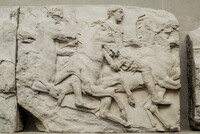Parthenon Sculpture: South Frieze
Phidias

Download7A3-G-BM-EM-5-B15_cp.jpg (400.5Kb)
Alternative Title
Elgin Marbles: South Frieze
Date
-438--432Description
Layered horses, overall view; "Elgin Marbles" is a popular term for the collection of sculpture from the Parthenon acquired by Lord Elgin in Athens between 1801-1805. The collection includes other works from the Acropolis as well. The Parthenon sculpture includes roughly half of what now survives: 247 feet of the original 524 feet of frieze; 15 of 92 metopes; 17 figures from the pediments, and various other pieces of architecture. The Parthenon Frieze is the low relief, pentelic marble sculpture created to adorn the upper part of the Parthenon’s naos. The iconography of the procession depicted is uncertain; it may be either the Greater Panathenaic procession from Eleusis to Athens, or may depict the founding myth of the city of Athens. The following ranks W21-1 along with N75-136 and S1-61 are all of horsemen and constitute 46% of the whole frieze. By N42 and S89 the equestrian parade is at an end. S119-121 are the skaphephoroi, the tray bearers of the honeycombs and cakes used to entice the sacrificial animals to the altar. S122-149 are the four cows and four sheep on the south meant for sacrifice. Source: British Museum [website]; http://www.britishmuseum.org (accessed 6/14/2009)
Type of Work
bas-relief (sculpture); frieze (ornamental area)Subject
animals, military, war, recreation and games, festivals, cavalcade, horse and rider, religious procession, equestrian parade, horses, calvary, animal sacrifice, Greek (ancient), Classical
Rights
Rights Statement
Licensed for educational and research use by the MIT community only